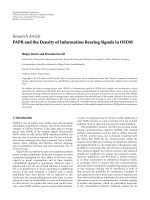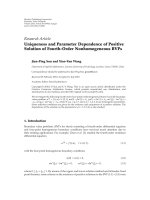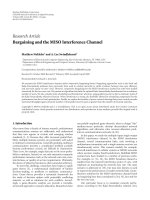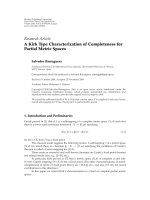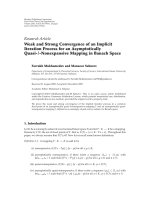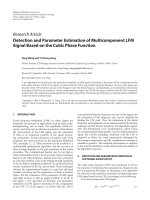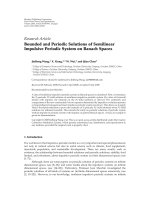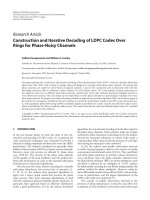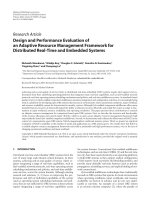Báo cáo hóa học: "Research Article PAPR and the Density of Information Bearing Signals in OFDM" docx
Bạn đang xem bản rút gọn của tài liệu. Xem và tải ngay bản đầy đủ của tài liệu tại đây (562.08 KB, 9 trang )
Hindawi Publishing Corporation
EURASIP Journal on Advances in Signal Pr ocessing
Volume 2011, Article ID 561356, 9 pages
doi:10.1155/2011/561356
Research Ar ticle
PAPR and the Density of Information Bearing Signals in OFDM
Holger Boche and Brendan Farrell
Lehrstuhl f¨ur Theoretische Informationstechnik, Technische Universit¨at M¨unchen, A rcisstraβe 21, 80333 M¨unchen, Germany
Correspondence should be addressed to Holger Boche,
Received 9 November 2010; Accepted 6 February 2011
Academic Editor: Simon Litsyn
Copyright © 2011 H. Boche and B. Farrell. This is an open access article distributed under the Creative Commons Attribution
License, which permits unrestricted use, distribution, and reproduction in any medium, provided the original work is properly
cited.
We address the peak-to-average power ratio ( PAPR) of transmission signals i n OFDM and consider the performance of tone
reservation for reduction of the PAPR. Tone reservation is unique among methods for reducing PAPR, because it does not affect
information bearing coefficients and involves no addition al coordination of tra nsmitter and receiver. It is shown that if the OFDM
system always satisfies a given peak-to-average power ratio constraint, then the efficiency of the system, defined as the ratio of the
number of tones used for information to the entire number of tones used, must converge to zero as the total number of tones
increases. More generally, we investigate and provide insight into a tradeoff between optimal signal and information properties for
OFDM systems and show that it is necessary to use very small subsets of the available signals to achieve PAPR reduction using tone
reservation.
1. Introduction
OFDM is one of today’s most widely used and promising
information t ransmission sche mes. One of the main disad-
vantages of OFDM, however, is the large peak-to-average
power ratio (PAPR) of the transmit signals. Reducing the
PAPR, which we will call the PAPR reduction problem, has
been an area of extensive research over the last ten years,
and various techniques have been proposed. These include,
among others, clipping and filtering, selected mapping,
active constellation extension, and tone reservation. See [1]
for an overview.
High PAPR is a problem because most amplifiers perform
poorly at higher amplitudes. Reduction techniques are most
commonly investigated for their effects on bit-error r ates,
capacity or power consumption, and in these contexts,
a probabilistic approach is appropriate. However, when a
signal’s peak is cut off, out-of-band radiation is caused, and
this is an interference for devices operating in neighboring
spectra. If the peak threshold is violated with a certain
probability, then other devices will be subjected to this
interference the corresponding percent of the time. In many
instances, it may be inadmissible to cause such interference
to other devices. We explain that when peak cutoff occurs,
only a strict PAPR criterion prevents out-of-band r adiation.
As such, our approach may be viewed as either addressing a
strict PAPR criterion or a strict criterion of no out-of-band
radiation. Such an approach is necessarily nonprobabilistic.
The probabilistic model is currently the accepted model
among communications engineers working with classical
wireless communications systems, such as cellular networks
or WLAN. In these areas, one is primarily concerned with
the effects that PAPR has for communication within the
frequency band that one is working. Developments related to
the digital dividend (i.e., the reallocation of frequencies made
available by converting radio and television communication
from analog to digital) have shown, however, that statistical
models are insufficient for various user-oriented commu-
nications applications and that there is strong resistance
in in these communities to redistribute frequency bands.
In particular, there is concern that new communications
networks will be introduced in neighboring frequency bands
or that frequency sharing w ill be introduced, as both of
these present the possibility for interference. Examples of
such applications where these issues are most important are
those where safety plays an important role, such as in wireless
automation or car-to-car communication. A further example
is wireless microphones, which are particularly important
in the entertainment industry. Statistical models can be
2 EURASIP Journal on Advances in Signal Processing
permitted in these areas only in very restricted cases. What
distinguishes these applications from classical networks is the
type of error that may be tolerated. In particular, a certain
probability that communication fails is inadmissible.
The starting point for the PAPR reduction schemes
mentioned above is a set of coefficients to be transmitted
to the receiver. In order to reduce t he signal peak, one may
adjust these coefficients in some way or add new coefficients
on frequencies that have not been used. If coefficients are
manipulated, then the receiver must convert the received
coefficients back to the original coefficients; however, if
coefficients are added on frequencies that do not carry
information, the received information bearing coefficients
do not have to be converted. Tone reservation, which was
introduced in [ 2], and is one of the popular techniques to
mitigate against high PAPR, takes the latter approach.
In tone reservation, the set of available tones is divided
into two subsets. One set is used to carry information, while
the other is used to reduce the peak value. We will call these
two sets the information set and the compensation set.Given
asetofcoefficientsforthetonesintheinformationset,
coefficients are chosen for tones in the compensation set, so
that the peak value of the combined signal is reduced. The
location of t hese two sets remains fixed for all codewords and
over all uses of the channel.
Of the handful of methods to reduce PAPR, tone reser-
vation is particularly robust and canonical. This is because
the only information that the receiver requires is the location
of the information set. The receiver may simply ignore
whatever arrives on the entries of the compensation set.
With other schemes, such as active constellation extension
[3] or selected mapping [4, 5], not only does the receiver
have to be informed of the modifications made to each
possible set of coefficients, but the receiver also has to convert
the received coefficients back to their original values. Thus,
there is additional overhead involved in setting up and t hen
performing the information transmission. Both of these are
avoided in tone reservation.
However, tone reservation exhibits a tradeoff between
the best attainable PAPR and the number of tones in the
information set. The main result presented here is that if
the OFDM system satisfies a strict bound on the peak-
to-average ratio, then as the number of total tones used
increases, at some point the proportion of tones used to
carry information must decrease and eventually converge
to zero. Equivalently, we find a scaling law: if the size of
the information set and the total set increase proportionally,
signals with larger peaks can be constructed that cannot be
compensated for by any compensation signal.
The result presented here certainly does not state that
tone reservation does not deliver strong improvements in
PAPR. An efficient algorithm for computing compensation
coefficients is given in [6], and the reductions it delivers in
PAPR are significant. Much experimentation has been done,
in particular in searching for subsets with good performance,
but t he structure of good sets is still not understood. There
has also been little theoretical work on the performance
bounds of tone reservation. The authors are unaware, for
example, of any work that addresses the behavior of tone
reservation as the number of tones increases. This paper
provides insight to this scheme as the number of tones
involved becomes large.
This paper provides an initial investigation into the rela-
tionship between the relative size of a subset of transmission
signals and several signal processing properties of the subset.
In Section 2, we prove our main result on tone reservation
for OFDM systems with a finite set of tones. In Section 3,
we prove the same type of result for systems with an infinite
number of tones. The discrete Fourier case is addressed in
Section 4, and a short conclusion is given in Section 5.There
we also give a short discussion of transmission schemes for
fifth generation cellular networks, as well as nonorthogonal
transmission systems and their PAPR behavior.
2. The Finite Set OFDM Case
We first define our signals: an OFDM signal has the form
s
(
t
)
=
N
k=−N
a
k
e
ikt
,(1)
where the coefficients a
k
either carry information or, in the
tone reser vation scheme, are used to reduce the peak value
of s(t). An amplifier generally only has a cutoff or distorting
effect at high amplitudes, and t he signal is left undisturbed
where it is magnitude lies below a threshold. In this case,
if
|s(t)| exceeds the threshold, say M,insomeregions,a
new function s
1
results, such that s(t) = s
1
(t)forallt
where
|s(t)|≤M.Then,s − s
1
has compact support and
cannot be band-limited. Since s is band-limited, this means s
1
cannot be band-limited, and thus out-of-band radiation has
been caused. This motivates the investigation of strict PAPR
constraints. The PAPR for the vector a is
PAPR
(
a
)
= sup
t∈[0,2π]
N
k
=−N
a
k
e
ikt
2
a
l
2
2N+1
. (2)
While this is the standard definition of PAPR, to make
notation easier, we look at
|
N
k
=−N
a
k
e
ikt
| rather than
|
N
k
=−N
a
k
e
ikt
|
2
. Also, we could work with just the nonnega-
tive indices rather than with all the frequencies
{−N, , N}.
Instead of working with L
1
(T) (defined below), we would
then work with the Hardy space H
1
. The results, however,
remain the same. Before we formally state the problem, we
define our spaces.
Definition 1. l
p
N
denotes C
N
viewed as a linear space and
x
l
p
N
= (
N
k
=1
|x
k
|
p
)
1/p
.IfA is a subset of {−N, , N},
l
p
(A) denotes vectors in l
p
2N+1
supported on A. T denotes
the torus. L
p
(T) denotes p-integrable functions defined on
T with norm
f
L
p
(T)
=
1
2π
T
f
(
t
)
p
dt
1/p
,(3)
for 1
≤ p<∞ and f
L
∞
(T)
= ess.sup
t∈T
|f (t)|. L
2
(A)
denotes the subspace of L
2
(T) spanned by {e
ik·
}
k∈A
.
EURASIP Journal on Advances in Sig nal Processing 3
Tone reservation works as follows: we split
{−N, , N}
into two subsets I
N
, an information set, and R
N
=
{−
N, , N}\I
N
, a compensation set. We call the ratio of the
number of tones in t he information set to the total number
of tones available the efficiency of the system. Using
|A| to
denote the number of elements in the set A,theefficiency
is
|I
N
|/(2N + 1). Given a set of information coefficients a ∈
l
2
(I
N
), one seeks a vector b ∈ l
2
({−N, , N}\I
N
) satisfying
b
l
2
2N+1
≤ C
Ex
a
l
2
2N+1
,suchthat
sup
t∈[0,2π]
k∈I
N
a
k
e
ikt
+
k∈R
N
b
k
e
ikt
≤
C
Ex
a
l
2
2N+1
,(4)
for some constant C
Ex
. One would like the infimum of (4)
over all possible b supported on R
n
. The condition b
l
2
2N+1
≤
C
Ex
a
l
2
2N+1
is, therefore, imposed to make this well-defined.
We note, though, that any vector b that satisfies (4)musthave
this property. To see this, we observe that
a
2
l
2
+ b
2
l
2
1/2
=
k∈I
N
a
k
e
ik·
+
k∈I
c
N
b
k
e
ik·
L
2
≤ sup
t∈[0,2π]
k∈I
N
a
k
e
ikt
+
k∈R
N
b
k
e
ikt
,
(5)
so that if (4) holds, then the condition
b
l
2
2N+1
≤ C
Ex
a
l
2
2N+1
is also satisfied. Certainly, for finite N, a constant C can
always be found that satisfies inequality (4). Here, however,
we address the relationship between N,thesizeofI
N
,andthe
best possible constant C
Ex
.
To express this relationship, we introduce the extension
operator,whichwedenoteE
I
N
.Thisoperatorisamapfrom
l
2
(I
N
)toL
2
({−N, , N}), given by
E
I
N
a =
k∈I
N
a
k
e
ikt
+
k∈R
N
b
k
e
ikt
. (6)
An initial formulation of solvability is that the PAPR reduc-
tion problem is solvable for the subset I
N
⊂{−N, , N}
with bound C
Ex
if there exists an operator E
I
N
: l
2
(I
N
) →
L
∞
({−N, , N})suchthatforalla ∈ l
2
(I
N
) satisfying
a
l
2
2N+1
≤ 1,
E
I
N
a
L
∞
(T)
≤ C
Ex
. (7)
Note that we are interested in an operator that satisfies
(7); uniqueness is not part of the discussion. Such an
operator will, in general, be nonlinear, since cases where
E
I
N
(a+b)
/
=E
I
N
a+E
I
N
b may exist. However, a ny such operator
scales sublinearly. That is, suppose that the PAPR reduction
problem as just defined is solvable for I
N
with constant C
Ex
.
If
a
l
2
2N+1
> 1, we define a
= a/a
l
2
2N+1
.Then,
E
I
N
a
L
∞
(T)
≤ C
Ex
,(8)
and we may simply rescale E
I
N
a
by a
l
2
2N+1
to determine
an extension for a with bound C
Ex
a
l
2
2N+1
.Notethathere
the placement of the coefficients is unchanged, and they are
all simply multiplied by the same appropriate scaling. Thus,
solvability o n all of l
2
(I
N
) and solvability on the unit ball of
l
2
(I
N
) are equivalent, though the best constant in the latter
case may be smaller.
Definition 2. The PAPR reduction problem is solvable for I
N
with bound C
Ex
if there exists an operator E
I
N
: l
2
(I
N
) →
L
∞
({−N, , N})suchthat
E
I
N
a
L
∞
(T)
≤ C
Ex
a
l
2
2N+1
,(9)
for every a
∈ l
2
(I
N
).
Now we proceed as follows: in Theorem 1 we give a
necessary condition for solvability. With Theorem 2 we show
that if it is required that the peak-to-average power ratio
remains bounded, then the efficiency of the OFDM system
conv erges to zero as the system size increases. That is, if the
PAPR reduction problem remains solvable with the same
bound for a sequence of sets
{I
N
} as N →∞, then the
relative density of the sets, that is, the ratio of information
bearing signals to total signals must converge to zero.
Definition 3. For a subset I
N
⊂{−N, , N} we define
F
(
I
N
)
=
⎧
⎨
⎩
f ∈ L
1
(
T
)
, f
(
t
)
=
k∈I
N
a
k
e
ikt
⎫
⎬
⎭
. (10)
Theorem 1 . If the PAPR problem is solvable for the subset I
N
with ex tension norm C
Ex
,then
f
L
2
(T)
≤ C
Ex
f
L
1
(T)
, (11)
for all f
∈ F (I
N
).
Proof. By assumption, for all s(t)
=
k∈I
N
a
k
e
ikt
, a
l
2
2N+1
≤
1,
E
I
N
a
l
∞
2N+1
≤ C
Ex
a
l
2
2N+1
≤ C
Ex
. (12)
Again, by assumption,
E
I
N
a
(
t
)
=
k∈I
N
a
k
e
ikt
+
k∈R
N
b
k
e
ikt
. (13)
Let f
∈ F (I
N
), f (t) =
k∈I
N
c
k
e
ikt
, be arbitrary. Then
k∈I
N
a
k
c
k
=
k∈I
N
a
k
c
k
+
k∈R
N
b
k
c
k
=
1
2π
T
f
(
t
)
E
K
s
(
t
)
dt
≤
f
L
1
(T)
E
K
s
L
∞
(T)
≤ C
Ex
f
L
1
(T)
.
(14)
Set
a
k
=
⎧
⎪
⎨
⎪
⎩
c
k
c
l
2
2N+1
c
k
/
=0,
0 c
k
= 0.
(15)
4 EURASIP Journal on Advances in Signal Processing
Then
f
L
2
(T)
=c
l
2
2N+1
=
k∈I
N
a
k
c
k
≤
C
Ex
f
L
1
(T)
. (16)
The following definition gives the efficiency of the best
subset selection for which the PAPR reduction problem is
solvable for a given bound.
Definition 4 (Optimal subset size-OFDM).
E
N
(
C
Ex
)
= max{|I
N
|; I
N
⊂{−N, , N },
such that PAPR is solvable for I
N
with constant C
Ex
}.
(17)
Now, we may state the following theorem.
Theorem 2. For all 0 <C
Ex
< ∞, the following limit holds:
lim
N →∞
E
N
(
C
Ex
)
2N +1
= 0. (18)
In other words, the theorem states that if a PAPR bound
is always satisfied, then the system efficiency converges to
0 as the total size increases. Thus, the number of tones
that may be used to carry information does not scale
with N. Theorem 2 gives a limiting value as the dimension
approaches infinity, but it should not be read as a strictly
asymptotic statement. Because of the convergence to zero,
(18) rules out the existence of any arbitrarily large dimen-
sions N for which solvability occurs or a certain parameter
pair C
Ex
and |I
n
|/n.Inotherwords,givenaconstantC
Ex
and
a relative density, there is a limit to how large the dimension
can be and sat isfy both the extension constant C
Ex
and the
prescribed relative density.
The p roof will use arithmetic progressions and Sze-
mer
´
edi’s Theorem, Theorem 3.
Definition 5. An arithmetic progression of length k is a subset
of
Z that has the form {a, a + d, a +2d, , a +(k − 1)d} for
some integer a and some positive integer d.
Theorem 3 (Theorem 1.2 in [7]). For any integer k
≥ 1
and an y 0 <δ
≤ 1, there exists an integer N
SZ
(k, δ) ≥ 1
such that for every N
≥ N
SZ
(k, δ),everysetA ⊂{1, , N}
of cardinality |A|≥δN contains at least one arithmetic
progression of length k.
Proof of Theorem 2. Assume that the claim is not true. Then,
there exists a subsequence
{N
k
}
∞
k=1
⊂ N and a constant
G(C
Ex
) > 0suchthat
E
N
k
(
C
Ex
, F
)
2N
k
+1
≥ G
(
C
Ex
)
(19)
for all k
= 1, 2, Now, we set δ = G(C
Ex
)/2 and apply
Szemer
´
edi’s Theorem, Theorem 3.Thus,foranym,there
exists some large N
∈{N
k
}
∞
k=1
such that I
N
contains an
arithmetic progression of length m. Denote this progression
{a + dl}
m−1
l
=0
.Now,notethat
1
√
m
m−1
l=0
e
i(a+dl)·
L
2
(T)
= 1, (20)
while
1
√
m
m−1
l=0
e
i(a+dl)·
L
1
(T)
≤
log
(
m/2
)
√
m
. (21)
(This is the usual bound for the Dirichlet kernel.) Applying
Theorem 1, for any fixed constant C
Ex
,(20)and(21)leadto
the contradiction
1
=
1
√
m
m−1
l=0
e
i(a+dl)·
L
2
(T)
≤ C
Ex
1
√
m
m−1
l=0
e
i(a+dl)·
L
1
(T)
≤ C
Ex
log
(
m/2
)
√
m
(22)
when m is large.
Thus, if a bound on the peak of all transmission signals is
given as one increases the number of total tones available,
at some size N the proportion of tones allocated to carry
information must decrease in order to satisfy the PAPR
constraint.
From this theorem, we also see that when tone reser-
vation is used, the subsets chosen as information and
compensation sets are very important. In particular, the
information set should not have any long arithmetic p ro-
gressions; however, determining subsets with little additive
structure is a very challenging problem. As an indication
of this, consider that what is now known as Szemer
´
edi’s
theorem was an open question for length 3 for decades before
Roth proved it in 1952 [8], for which he was awarded the
Fields Medal in 1958. Szemer
´
edi proved the result for length
4 in 1969 [9] and his final result in 1975 [10]. Sets with only
short arithmetic progressions is certainly a nearly equivalent
problem and thus also very difficult. For a taste of this area,
onemayseeChapter2of[11].
The following theorem shows that if the PAPR reduction
problem is solvable for a finite information set when we allow
thecompensationsettobetheentirerestoftheintegers;
then,usingaprojectionontoafiniteset,weobtainsolvability
for the finite compensation set. However, the extension norm
increases depending on the size of the compensation set.
Theorem 4. Suppose that I
N
is a subset of {−N, , N } and
that for e very a
∈ l
2
(Z) supported on I
N
the PAPR reduction
problem is solvable with an extension sequence supported on
Z \ I
N
and with extension bound C
Ex
. Assume that λ>1
and that λN is an integer. Then the PAPR reduction problem
is also solvable with an extension sequence supported on
{−λN, , λN}\I
N
with ex tension constant (2/(λ −1))C
Ex
.
EURASIP Journal on Advances in Sig nal Processing 5
Proof. Let f (t)
=
n∈I
N
a
n
e
int
,andlet
f
(
t
)
+ g
(
t
)
=
n∈I
N
a
n
e
int
+
n∈Z\I
N
a
n
e
int
(23)
be its extension, such that
f + g
L
∞
(T)
≤ C
Ex
a
l
2
(Z)
.We
simply project f + g onto span
{e
in·
}
λN
n
=−λN
using a Fej
´
er
kernel. We define the following set of kernels:
K
N,λ
=
⎧
⎨
⎩
K
(
t
)
=
N
n=−N
e
int
+
−N−1
n=−λN
d
n
e
int
+
λN
n=N+1
d
n
e
int
,
where d
n
= d
−n
for n = N +1, , λN
⎫
⎬
⎭
.
(24)
For any kernel K
∈ K
λ,N
,wehave
f
(
t
)
=
1
2N +1
N
n=−N
f
2πl
2N +1
K
t −
2πl
2N +1
, (25)
and we may define f + g
λN
to be the convolution of f + g
with K. The Fourier expansion of f + g
λN
is supported on
{−λN, , λN } and agrees with a on I
N
.UsingP
K
to denote
the projection given by convolution with K,
f + g
λN
L
∞
(T)
≤P
K
f +
g
L
∞
(T)
≤ C
Ex
a
l
2
(Z)
P
K
.
(26)
The norm
P
K
is the ·
L
1
(T)
-norm of K.Wewillconstruct
K using two Fej
´
er kernels. We recall that the Dirichlet kernel
is defined by
D
n
(
t
)
=
n
k=−n
e
ikt
, (27)
and the Fej
´
er kernel by
F
n
(
t
)
=
1
n
n−1
k=0
D
n
=
sin
(
nt/2
)
sin
(
t/2
)
2
.
(28)
Thus, for any m>l,
m
k=0
D
k
−
l
k=0
D
k
=
(
m
− l
)
2l−m
k=0
e
ikt
+ e
−ikt
+
2
(
m−l
)
k=1
m − l −
k
2
e
i(2l−m+k)t
+ e
−i(2l−m+k)t
.
(29)
By setting d
k
= (λN −N − (k/2)) for k = N +1, , λN and
K(t)
= 1/(λN − N)(
λN
k
=0
D
k
(t) −
N
k
=0
D
k
(t)) and using the
positivitygivenin(29), we obtain
K
L
1
([0,1])
=
1
0
1
λN − N
⎛
⎝
λN
k=0
D
k
(
t
)
−
N
k=0
D
k
(
t
)
⎞
⎠
dt
≤
1
λN − N
1
0
λN
k=0
D
k
(
t
)
+
N
k=0
D
k
(
t
)
dt
≤
2λN
λN − N
=
2
λ − 1
.
(30)
Returning to (26), we have
f + g
λN
L
∞
(T)
≤
2
λ − 1
C
Ex
a
l
2
(Z)
, (31)
where the Fourier expansion of g
λN
is supported on
{−λN, , λN}\I
N
.
3. The Infinite Set Case
The infinite set case is particularly important because of
the insight it brings to the mathematical structure of tone
reservation. By using the projections discussed in Theorem 4
though, the infinite set case also has practical implications.
Our first step en route to proving the infinite-dimensional
form of Theorem 2 is to prove an equivalence between the
PAPR reduction problem and a norm equivalence. Recall that
Theorem 1 stated that solvability implies a norm equivalence
in the finite set case. In the infinite set case, we show that
solvability holds if and only if the norm equivalence holds. By
constructing functions that violate the norm relation, we will
show when solvability cannot hold (Theorem 6). However,
using a special case when the norm relation holds, we will use
the if and only if statement to identify sets where solvability
does hold (Theorem 7).
The equivalence statement holds for arbitrary orthonor-
malsystems,sowestateitinthatgenerality.Thisis
Theorem 5.InTheorem 6, we prove that the PAPR problem
is not solvable in the OFDM setting at positive efficiencies
for sets of infinite cardinality. Let
{ψ
k
}
k∈Z
be an orthonormal
basis for L
2
(T). Let K be a subset of Z and define
X :
=
⎧
⎨
⎩
f ∈ L
1
(
T
)
: f
(
t
)
=
k∈K
a
k
ψ
k
(
t
)
⎫
⎬
⎭
. (32)
Given a function s
∈ X, we are interested in finding a
compensation function g, g(t)
=
k∈K
c
b
k
ψ
k
,suchthat
s + g
∞
≤ C
Ex
s
2
. Here, we may view the nonlinear
operator as a map from L
2
(T)toL
2
(T), so that E
K
s = s + g.
If a map exists so that such a g can be found for every s
∈ X,
then we say that the PAPR reduction problem is solvable for
the pair K and
{ψ
k
}
k∈Z
with extension norm C
Ex
.
6 EURASIP Journal on Advances in Signal Processing
Theorem 5. The PAPR problem is solvable for the pair K and
{ψ
k
}
k∈Z
with ex tension norm C
Ex
if and only if
f
L
2
(T)
≤ C
Ex
f
L
1
(T)
, (33)
for all f
∈ X.
Remark 1. We give a short discussion of the geometric
interpretation of this theorem in our conclusion in Section 5.
When (33) holds, we will say that X has the norm
equivalence property. Note that in contrast to the finite set
case of Theorem 1,herewehaveanecessaryandsufficient
condition for solvability.
Before giving the proof of Theorem 5 we emphasize
several p oints. I f C
Ex
is the smallest constant for which the
reduction problem is solvable, then it is also the smallest
constant for which (33) holds and vice versa. To see this,
suppose that C
1
is the smallest constant for which solvability
holds, but the norm equivalence holds for C
2
<C
1
.By
the equivalence statement of Theorem 5, solvability also
holds for C
2
, w hich contradicts that C
1
is the smallest
such constant. The same argument applies for the opposite
implication as well. The statement that the best constant for
the norm relation is also the best constant for solvability is
the more significant, since here, this property follows from
the Hahn-Banach Theorem. The Hahn-Banach Theorem,
however, requires the axiom of choice to repeatedly extend
the functional’s domain by one dimension. Indeed, here the
axiom of choice is used to justify this because in most settings
it cannot be done constructively. Therefore, constructing an
extension with the optimal constant is equivalent to realizing
what the axiom of choice states exists, but for which a
method of construction does not exist. This shows how
mathematically complex an o ptimal implementation of tone
reservation is.
Proof. (i) Assume t hat the PAPR problem is solvable. Then,
for all s(t)
=
k∈K
a
k
ψ
k
(t), a
l
2
(Z)
≤ 1,
E
K
s
L
∞
(T)
≤ C
Ex
s
L
2
(T)
≤ C
Ex
. (34)
Since L
∞
(T) ⊂ L
2
(T),
E
K
s =
k∈K
a
k
ψ
k
+
k∈Z\K
b
k
ψ
k
. (35)
Let f
∈ X, f (t) =
k∈K
c
k
ψ
k
(t), be arbitrary. Then,
k∈K
a
k
c
k
=
k∈K
a
k
c
k
+
k∈Z\K
b
k
c
k
=
1
2π
T
f
(
t
)
E
K
s
(
t
)
dt
≤
f
L
1
(T)
E
K
s
L
∞
(T)
≤ C
Ex
f
L
1
(T)
.
(36)
Set
a
k
=
⎧
⎪
⎨
⎪
⎩
c
k
c
l
2
c
k
/
=0,
0 c
k
= 0.
(37)
Then,
f
L
2
(T)
=c
l
2
=|
k∈K
a
k
c
k
|≤C
Ex
f
L
1
(T)
.
(ii) Assume
f
L
2
(T)
≤ C
Ex
f
L
1
(T)
for all f ∈ X.Let
a
∈ l
2
(Z) be a sequence supported in K with only finitely
many nonzero terms satisfying
a
l
2
(Z)
≤ 1. Set s(t) =
k∈K
a
k
ψ
k
(t). For f ∈ X, f (t) =
k∈K
c
k
ψ
k
(t), define the
functional Ψ
a
by
Ψ
a
f =
k∈K
a
k
c
k
. (38)
Since
Ψ
a
f
≤
a
l
2
(Z)
c
l
2
(Z)
≤
f
L
2
(T)
≤ C
Ex
f
L
1
(T)
,
(39)
Ψ
a
is continuous on X.SinceX is a closed subspace of L
1
(T),
by the Hahn-Banach Theorem [12], the functional Ψ
a
has the
extension Ψ
E
to all of L
1
(T), where Ψ
a
=Ψ
E
. The dual
of L
1
(T)isL
∞
(T). Thus, for some r ∈ L
∞
(T),
Ψ
E
f =
f , r
, (40)
for all f
∈ L
1
(T), so that Ψ
E
=r
L
∞
(T)
.SinceL
∞
(T) ⊂
L
2
(T), r possesses the unique expansion
r
(
t
)
=
k∈Z
d
k
ψ
k
(
t
)
, (41)
for some d
∈ l
2
(Z). The sequences d and a agree on K,and
we define E
K
s := r.
Theorem 6. For K ⊂ Z,letS(N) = K ∩{−N, ,0, , N}.
If lim sup
N →∞
(|S(N)|/(2N +1))> 0, then the PAPR problem
is not solvable for K and the Fourier basis
{e
ik·
}
k∈Z
.
In particular, this theorem states that if the ratio of
the number of basis functions used for transmission to the
total number of basis functions does not tend to zero, then
arbitrarily high peaks can be constructed that cannot be
sufficiently dampened by any compensation function.
Similar questions concerning the s izes of subsets of
orthonormal bases that have a norm equivalence have been
studied. In [13], Bourgain addresses an L
2
− L
p
norm
equivalence for p>2. The general technique used here
to determine a norm equivalence is w ell known in the
functional analysis and local Banach space community.
Proof. First suppose that the PAPR problem is solvable for K
and
{e
ik·
}
k∈Z
. We develop a contradiction to the equivalence
given in Theorem 5. Suppose that arbitrary subsets S(N)of
{−N, , N} are chosen such that
lim sup
N →∞
|S
(
N
)
|
2N +1
= δ>0. (42)
EURASIP Journal on Advances in Sig nal Processing 7
For a ny positive integer k, using Szemer
´
edi’s Theorem
(Theorem 3) again, there exists a large integer N such that
S(N) has an arithmetic progression of length k.Denotethe
arithmetic progression
{a + dl}
k−1
l
=0
.Weagainhave
1
√
k
k−1
l=0
e
i(a+dl)·
L
2
= 1, (43)
while
1
√
k
k−1
l=0
e
i(a+dl)·
L
1
≤
log
(
k/2
)
√
k
. (44)
Applying Theorem 5, for any fixed constant C
Ex
,fork large
enough lines (43)and(44)givethecontradiction
1
=
1
√
k
k−1
l=0
e
i(a+dl)·
L
2
≤ C
Ex
1
√
k
k−1
l=0
e
i(a+dl)·
L
1
≤ C
Ex
log
(
k/2
)
√
k
.
(45)
We point out that the sequence of coefficients used to give
the contradiction is not at all exotic–it is just a sequence of 1’s
placed at the right locations.
If we work with a finite total number of tones and have an
extension constant C
Ex
,thensincetheconstantC
Ex
in both
aspects of Theorem 5 is the same, we can deduce a bound on
the longest arithmetic progression in I
N
. Namely, denoting
by k the length of t he longest arithmetic progression, we have
1
≤ C
Ex
(log(k)/
√
k).
To emphasize t he role of the density, we contrast
Theorem 6 with the following theorem.
Theorem 7 ([14] and Theorem III.F.6 in [15]). Let λ>1 be
a real number and assume that the subset K
={n
k
}
∞
k=1
⊂ Z
has the property |n
k+1
|≥λ|n
k
| for all k ≤ 1. Then there
exists a constant C
K
such that for all a ∈ l
2
supported on
K there exists a continuous function g
∈ L
2
(T) satisfying
g
L
∞
≤ C
K
a
l
2
with Fourier coefficients satisfying g
h
k
= c
n
k
.
That is, a compensation signal exists.
InthecaseaddressedinTheorem 7,acompensation
signal can always be found. But, of course, the difference is
that the density of K is zero: for every M elements of K we
have roughly λ
M
elements in the compensation set.
Now we give an example of when uncontrollable peaks
can occur (see also Section 5.2 of [16]). Consider a sequence
c
∈ l
2
(Z) supported on the positive integers, and such that
lim
K →∞
K
k
=1
c
k
=∞.LetM be a large positive integer and
set t
N,M
= N2
−M
for any N ≤ 2
−M
.SetK
N,M
to be the
smallest value for k such that 2
k−M
N is an integer. We then
have
K
k=1
c
k
e
2πi2
k
t
N,M
=
K
k=1
c
k
e
2πi2
k−M
N
=
K
N,M
k=1
c
k
e
2πi2
k−M
N
+
K
k=K
N,M
+1
c
k
.
(46)
Clearly, the term on the left remains bounded, while the
term on the right tends to infinity as K
→∞.However,
since the indices
{2
k
}
∞
k=0
correspond to λ = 2inTheorem 7,
there exists a sequence a supported on
Z \{2
k
}
∞
k=0
such that
a
l
2
(Z)
≤ C
Ex
c
l
2
(Z)
for a constant independent of c and
k∈N
c
2
k
e
2πik·
+
k∈Z\
{
2
k
}
∞
k=0
c
k
e
2πik·
L
∞
([0,1])
≤ C
Ex
. (47)
One could ask if all subsets of
Z of density zero might
correspond to a subspace for which the PAPR reduction
problem is solvable or, equivalently, for which a norm
equivalence holds. Here, however, a famous result tells us that
this is not the case. That is, Green and Tao have proved the
following theorem.
Theorem 8 (see [17]). The prime numbers contain arithmetic
progressions of arbitrary length.
Thus, the primes are an example of a subset of the
natural numbers with density zero, but for which the PAPR
reduction problem is not solvable.
4. The Discrete Fourier Case
For completeness, we include a short section on the discrete
Fourier case. The discrete setting is important, because it
is often used to model or approximate the analog setting.
Using sampling theorems, one can than relate results from
the discrete setting to the continuous setting. This is done
in the papers [6, 18, 19]. Also, if a signal has been digitized,
then it falls into the discrete, finite-dimensional setting. The
proofs and a more thorough discussion of the work presented
here can be found in [20].
Definition 6. The N
× N inverse discrete Fourier transform
(DFT) matrix is given by
F
jk
=
1
√
N
e
−2πi(j−1)(k−1)/N
. (48)
This matrix is denoted F,andforx
∈ l
2
N
, Fx denotes this
matrix applied to x.
Definition 7. The unit ball in l
p
N
is denoted B
p
N
;thatis,
B
p
N
=
x ∈ l
p
N
: x
l
p
N
≤ 1
. (49)
Since for any finite N solvability in the finite-dimensional
setting holds for some constant, we must consider a sequence
8 EURASIP Journal on Advances in Signal Processing
of subsets for an increasing sequence of dimensions and
address whether the solvability constant remains bounded.
Thus, we assume t hat
{N
k
}
∞
k=1
is an increasing sequence or
natural numbers, and for each N
k
we have a subset I
N
k
of
{1, , N
k
}. Here, I
c
N
k
denotes {1, , N
k
}\I
N
k
. Similarly to
Definition 2, the discrete PAPR problem is solvable for the
sequences
{N
k
}
∞
k=1
and {I
N
k
}
∞
k=1
if there exists a constant C
Ex
,
such that for each k,forallx
∈ l
2
N
k
with supp(x) ⊂ I
N
k
,there
exists a compensation vector r
∈ l
2
N
k
supported in I
c
N
k
such
that
F(x + r)
l
∞
N
k
≤
C
Ex
N
k
x
l
2
N
k
. (50)
Theorem 9 (see [20]). Let
{N
k
}
∞
k=1
be a subsequence of N,
and let I
N
k
be a subset of {1, , N
k
}.LetY
k
={y ∈ l
2
N
k
:
supp(F
∗
y) ⊂ I
N
k
}. The discrete PAPR problem is solvable for
the sequence of sets
{I
N
k
}
∞
k=1
with constant C
Ex
if and only if
y
l
2
N
k
≤
C
Ex
N
k
y
l
1
N
k
(51)
for all y
∈ Y
k
.
Note that
y
l
2
N
k
≤y
l
1
N
k
holds for any vector y.Butask
increases, at some point C
Ex
/
N
k
< 1, and so the important
point is that C
Ex
remains fixed.
For a set A,
|A| denotes its cardinality.
Theorem 10 (see [20]). Let
{N
k
}
∞
k=1
be a subsequence of N,
and let I
N
k
be the corresponding sets as defined earlier. If
lim sup
n →∞
I
N
k
N
k
> 0, (52)
then the discrete PAPR problem is not solvable.
The proof uses the finite-dimensional equivalence rela-
tion in Theorem 9 and Szemer
´
edi’s Theorem, just as the
proof of Theorem 6 used the L
2
− L
1
equivalence relation,
Theorem 5, and Szemer
´
edi’s Theorem.
5. Discussion and Conclu sion
The approach to the PAPR reduction problem presented
here has two parts: first, we showed an equivalence between
solvability and a norm relation, and then we considered cases
when we could violate or satisfy the norm relation. There
is a ver y interesting difference between these two parts in
that the equivalence statement holds for any orthonormal
basis and proving the statement did not require working with
the functions. The second step, however, required using the
special structure of the Fourier system. In [20], we present
the analogous result for the Walsh or CDMA system, and
there we also use every special property of that system. We
make the heuristic conjecture that if an orthonormal basis
has structure, then one can construct a function in the span
of a subset of elements with p ositive relative densit y that
violates the norm relation.
Compare t his conjecture with the following observation.
Paley’s Theorem (Theorem I.B.24 in [15]) states th at there
exists a constant C such that for f (t)
=
n
k
=1
a
k
e
2
k
πit
for any
n
∈ N
f
L
2
([0,1])
≤ C
f
L
1
([0,1])
. (53)
Thus, if we rearrange the Fourier b asis by repeatedly
taking one element from the set
{e
2
k
πi·
}
∞
k=1
and one from its
complement, we can acheive solvability for a subset with a
relative density of one half, by the definitions used here. What
is lost, however, is the structure. Here, the highest frequency
grows exponentially with respect to the total number of
signals.
The Khinchine inequality (I.B.8 in [15]) is the analogous
statement to Paley’s Theorem for the Walsh basis. Her e,
again, one could gain solvability by taking the elements
with indices
{2
k
}
n
k
=1
, but one then loses the structure and
the desireable properties. For example, with the natural
ordering one can move from the infinite setting to the finite
setting with the optimal projection constant 1. But if one
deviates from this ordering, this very helpful property is lost.
This relationship between structure and norm equivalences
requires much further study .
This paper shows that the PAPR reduction problem
is a challenging mathematical problem, both for general
orthonormal systems and for specific systems, such as
OFDM. Specific orthonormal systems demonstrate their
own difficult properties: for example, with OFDM we have
seen that the ordering of the elements plays an important role
and allows one to introduce the density that was investigated
here. Thus, the notion of density, as investigated here, is
fundamentally tied to the OFDM system.
On the other hand, there are results that hold for all
orthonormal systems. Here, for example, we see that the
worst case PAPR behavior of an OFDM signal is just an
instance of the
√
N behavior of any N orthonormal signals
[16]. A theorem of Kashin and Tzafriri [21]statesthat
under very reasonable conditions the expected maximum of
a signal formed as a linear combination of N orthonormal
functions on the unit interval behaves like
log(N). This
is discussed in [22], where it is also shown that a signal’s
PAPR value is highly concentrated in probability around
its expectation. This may be compared to probabilistic
bounds for the OFDM system in [23]. Thus, even in
expectation, the PAPR behavior of the OFDM system is, in
fact, just an instance of a uniform behavior. Understanding
these properties is particularly important for the emerging
effort in communications research to address overall energy
consumption, rather than considering only the energy of
the transmitted signal. In particular, one must address how
much energy is necessary to create a certain signal in terms
of the signal’s properties. In this way, one can address the
relationship between signal properties, such as PAPR, and
circuit design with the goal of reducing energy consumption
at the circuit level; see [24] for a recent discussion.
This paper is a contribution to the mathematical under-
standing of peak-to-average power ratio and, in particular,
tone reservation. We have shown that tone reservation
is inherently related to such mathematical areas as the
Hahn-Banach Theorem, norm equivalences, and arithmetic
EURASIP Journal on Advances in Sig nal Processing 9
progressions, and presented results in each of these areas.
The general result of the paper is that is a fixed portion of
subcarriers is always allocated for carrying information, then
signal peaks cannot be held below a fixed threshold.
Acknowledgment
H. Boche was supported by startup funds of the Technische
Universit
¨
at M
¨
unchen, and B. Farrell was supported by the
German Research Foundation (DFG) u nder Project BO
1734/18-1.
References
[1] S. H. Han and J . H. Lee, “An overview of peak-to-average
power ratio reduction techniques for multicarrier transmis-
sion,” IEEE Transactions on Wireless Communications, vol. 12,
no. 2, pp. 56–65, 2005.
[2]J.TelladoandJ.M.Cioffi,“Efficient algorithms for reducing
par in multicarrier systems,” in Proceedings of the IEEE
International Symposium on Information Theory (ISIT ’98),p.
191, Cambridge, Mass, USA, August 1998.
[3] B. S. Krongold and D. L. Jones, “PAR reduction in OFDM
via active constellation extension,” IEEE Transactions on
Broadcasting, vol. 49, no. 3, pp. 258–268, 2003.
[4] R. B
¨
auml,R.F.H.Fischer,andJ.B.Huber,“Reducingthe
peak-to-average power ratio of multicarrier modulation by
selected mapping,” IEEE Transactions on Information Theory,
vol. 32, pp. 2056–2057, 1996.
[5] M. Breiling, S. H. M
¨
uller-Weinfurtner, and J. B. Huber, “SLM
peak-power reduction without explicit side information,”
IEEE Communications Letters, vol. 5, no. 6, pp. 239–241, 2001.
[6] J. Ilic and T. Strohmer, “PAPR reduction in OFDM using
kashin’s representation,” in Proceedings of the 10th IEEE Work-
shop on Signal Processing Advances in Wireless Communications
(SPAWC ’09), pp. 444–448, June 2009.
[7] T. Tao, “A quantitative ergodic theory proof of Szemer
´
edi’s
theorem,” Electronic Journal of Combinatorics, vol. 13, no. 1,
pp. 1–49, 2006.
[8] K. F. Roth, “Sur quelques ensembles d’entiers,” Comptes-
Rendus de l’Acad´emie des Sciences de Paris, vol. 234, pp. 388–
390, 1952.
[9] E. Szemer
´
edi, “On sets of integers containing no four elements
in arithmetic progression,” Acta Mathematica Academiae
Scientiarum Hungaricae, vol. 20, no. 1-2, pp. 89–104, 1969.
[10] E. Szemer
´
edi, “On sets of integers containing no k elements
in arithmetic progression,” Acta Arithmetica, vol. 27, pp. 199–
245, 1975.
[11] T. Tao and V. Vu, Additive Combinatorics,CambridgeUniver-
sity Press, Cambridge, Mass, USA, 2006.
[12] W. Rudin, Real and Complex Analysis, McGraw-Hill, New
York, NY, USA, 3rd edition, 1987.
[13] J. Bourgain, “Bounded orthogonal systems and the Λ(p)-set
problem,” Acta Mathematica, vol. 162, no. 1, pp. 227–245,
1989.
[14] R. E. A. C. Paley, “On the lacunary coefficients of power series,”
Annals of Mathematics, vol. 34, no. 3, pp. 615–616, 1933.
[15] P. Wojtaszczyk, Banach Spaces for Analysts,vol.25ofCam-
bridge Studies in Advanced Mathematics,CambridgeUniver-
sity Press, Cambridge, Mass, USA, 1991.
[16] H. Boche and V. Pohl, “Signal representation and
approximation-fundamental limits,” European Transactions
on Telecommunications, vol. 18, no. 5, pp. 445–456, 2007.
[17] B. Green and T. Tao, “The primes contain arbitrarily long
arithmetic progressions,”
Annals of Mathematics, vol. 167, no.
2, pp. 481–547, 2008.
[18] C. Tellambura, “Computation of the continuous-time PAR of
an OFDM signal with BPSK subcarriers,” IEEE Communica-
tions Letters, vol. 5, no. 5, pp. 185–187, 2001.
[19] G. Wunder and H. Boche, “Peak value estimation of bandlim-
ited signals from their samples, noise enhancement, and a local
characterization in the neighborhood of an extremum,” IEEE
Transactions on Signal Processing, vol. 51, no. 3, pp. 771–780,
2003.
[20] H. Boche and B. Farrell, “On the peak-to-average power ratio
reduction problem for orthonormal transmission schemes,”
Submitted.
[21] B. Kashin and L. Tzafriri, “Lower estimates for the supremum
of some random processes,” East Journal on Approximations,
vol. 1, no. 1, pp. 125–139, 1995.
[22] B. Farrell and H. Boche, “Worst case and expected peak-to-
average power ratio for orthonormal systems,” in Proceedings
of the IEEE International Conference on Communications
(ICC ’11), 2011.
[23] G. Wunder and H. Boche, “ Upper bounds on the statistical
distribution of the crest-factor in OFDM transmission,” IEEE
Transactions on Information T heory, vol. 49, no. 2, pp. 488–
494, 2003.
[24] A. Mezghani and A. Nossek, “Power efficiency in wireless
networks from a circuit perspective,” in Proceedings of the IEEE
International Symposium on Circuits and Systems (ISCAS ’11),
2011.
